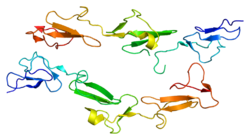
Back ADGRE2 Welsh EMR2 Persian ADGRE2 French EMR2 Russian EMR2 Serbo-Croatian EMR2 Serbian ADGRE2 Ukrainian
| ADGRE2 | |||||||||||||||||||||||||||||||||||||||||||||||||||
|---|---|---|---|---|---|---|---|---|---|---|---|---|---|---|---|---|---|---|---|---|---|---|---|---|---|---|---|---|---|---|---|---|---|---|---|---|---|---|---|---|---|---|---|---|---|---|---|---|---|---|---|
 | |||||||||||||||||||||||||||||||||||||||||||||||||||
| |||||||||||||||||||||||||||||||||||||||||||||||||||
| Identifiers | |||||||||||||||||||||||||||||||||||||||||||||||||||
| Aliases | ADGRE2, CD312, VBU, EMR2, adhesion G protein-coupled receptor E2, CD97 | ||||||||||||||||||||||||||||||||||||||||||||||||||
| External IDs | OMIM: 606100; HomoloGene: 113735; GeneCards: ADGRE2; OMA:ADGRE2 - orthologs | ||||||||||||||||||||||||||||||||||||||||||||||||||
| |||||||||||||||||||||||||||||||||||||||||||||||||||
| |||||||||||||||||||||||||||||||||||||||||||||||||||
| |||||||||||||||||||||||||||||||||||||||||||||||||||
| |||||||||||||||||||||||||||||||||||||||||||||||||||
| Wikidata | |||||||||||||||||||||||||||||||||||||||||||||||||||
| |||||||||||||||||||||||||||||||||||||||||||||||||||
EGF-like module-containing mucin-like hormone receptor-like 2 also known as CD312 (cluster of differentiation 312) is a protein encoded by the ADGRE2 gene.[3] EMR2 is a member of the adhesion GPCR family.[4][5] Adhesion GPCRs are characterized by an extended extracellular region often possessing N-terminal protein modules that is linked to a TM7 region via a domain known as the GPCR-Autoproteolysis INducing (GAIN) domain.[6]
EMR2 is expressed by monocytes/macrophages, dendritic cells and all types of granulocytes.[7] In the case of EMR2 the N-terminal domains consist of alternatively spliced epidermal growth factor-like (EGF-like) domains. EMR2 is closely related to CD97 with 97% amino-acid identity in the EGF-like domains. The N-terminal fragment (NTF) of EMR2 presents 2-5 EGF-like domains in human.[8] Mice lack the Emr2 gene.[9] This gene is closely linked to the gene encoding EGF-like molecule containing mucin-like hormone receptor 3 EMR3 on chromosome 19.
- ^ a b c GRCh38: Ensembl release 89: ENSG00000127507 – Ensembl, May 2017
- ^ "Human PubMed Reference:". National Center for Biotechnology Information, U.S. National Library of Medicine.
- ^ Hamann J, Aust G, Araç D, Engel FB, Formstone C, Fredriksson R, et al. (April 2015). "International Union of Basic and Clinical Pharmacology. XCIV. Adhesion G protein-coupled receptors". Pharmacological Reviews. 67 (2): 338–67. doi:10.1124/pr.114.009647. PMC 4394687. PMID 25713288.
- ^ Stacey M, Yona S (2011). Adhesion-GPCRs: Structure to Function (Advances in Experimental Medicine and Biology). Berlin: Springer. ISBN 978-1-4419-7912-4.
- ^ Langenhan T, Aust G, Hamann J (May 2013). "Sticky signaling--adhesion class G protein-coupled receptors take the stage". Science Signaling. 6 (276): re3. doi:10.1126/scisignal.2003825. PMID 23695165. S2CID 6958640.
- ^ Araç D, Boucard AA, Bolliger MF, Nguyen J, Soltis SM, Südhof TC, Brunger AT (March 2012). "A novel evolutionarily conserved domain of cell-adhesion GPCRs mediates autoproteolysis". The EMBO Journal. 31 (6): 1364–78. doi:10.1038/emboj.2012.26. PMC 3321182. PMID 22333914.
- ^ Lin HH, Stacey M, Hamann J, Gordon S, McKnight AJ (July 2000). "Human EMR2, a novel EGF-TM7 molecule on chromosome 19p13.1, is closely related to CD97". Genomics. 67 (2): 188–200. doi:10.1006/geno.2000.6238. PMID 10903844.
- ^ Gordon S, Hamann J, Lin HH, Stacey M (September 2011). "F4/80 and the related adhesion-GPCRs". European Journal of Immunology. 41 (9): 2472–6. doi:10.1002/eji.201141715. PMID 21952799. S2CID 29257475.
- ^ Kwakkenbos MJ, Matmati M, Madsen O, Pouwels W, Wang Y, Bontrop RE, Heidt PJ, Hoek RM, Hamann J (December 2006). "An unusual mode of concerted evolution of the EGF-TM7 receptor chimera EMR2". FASEB Journal. 20 (14): 2582–4. doi:10.1096/fj.06-6500fje. PMID 17068111. S2CID 16254868.
© MMXXIII Rich X Search. We shall prevail. All rights reserved. Rich X Search


